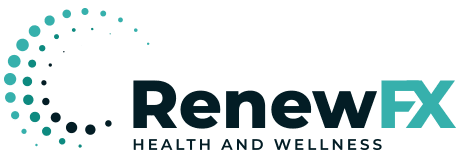Understanding the hazards of estrogen dominance and the prevention of this condition is important to maintaining optimal, long term health in women. RenewFX Health medical specialists provide a proactive, preventive approach utilizing Bio-identical Hormone Therapy solutions to reverse and correct this medical condition.
Estrogen Dominance is characterized by a relative excess of estrogen and a corresponding deficiency in progesterone. In the U.S. alone, statistics show that nearly 50% of woman over age 35 have an estrogen dominance condition. Proactively managing your hormonal balance throughout your life is the best preventive medicine to maintain and protect your health.
In women, from age 35 to 50, there is a 75% reduction in production of progesterone in the body. Conversely, Estrogen, during the same period, only declines about 35%. By menopause, the total amount of progesterone made is extremely low, while estrogen is still present in the body at about half its pre-menopausal level. As a result, this excess estrogen becomes dominant over deficient progesterone levels.
As an adult, estrogen plays the same role it did in puberty. In excess it will continue to develop larger hips and in breast tissue, it may continue to support growth and cause cysts. Progesterone is its antagonist and is responsible for limiting estrogen’s effects from continuing unregulated.
In menstruation, estrogen begins to develop and thicken the lining of the uterus while progesterone stops the growth and allows the thickened lining to slough off. A perfect balance of these two hormones allows you to completely avoid breast tenderness, painful periods, endometriosis, mood swings, irritability and even anxiety or depression.
What if my estrogen and progesterone aren’t in balance?
First off, it is very common for these two to be out of balance; so common you might even say that it is normal. But from a physiological standpoint it’s not normal. Normal physiology is in balance. Proper balance of estrogen and progesterone keeps you happy, maintains your libido (along with proper testosterone ratio’s), and allows your monthly cycle to pass without a monthly week of symptoms (aka PMS). If this blissful experience is not what you’re currently experiencing… then continue reading.
Estrogen Dominance
Estrogen dominance is a term used to describe one of two major types of estrogen excess. The first is excess estrogen and normal progesterone and the second more common type is estrogen excess with low progesterone. Estrogen dominance has become eerily too common in women.
Do You Have Estrogen Dominance?
One of the most obvious signs you might be estrogen dominant is weight gain. Estrogen is the hormone (actually a group of 3 hormones, E1, E2 and E3) that is responsible for depositing fat. These hormones are highly correlated to some of the different body shapes you see. They like to deposit fat in the abdomen, thighs, back of the arms and even contribute to a woman’s apple shape developed (and needed) during pregnancy.
To make things worse, excess estrogen actually binds to thyroid hormones and prevents their normal activity, making you gain yet more weight and feel tired all the time. This is where things get really bad, because thyroid hormone is required to help the liver detoxify excess estrogen and that is blocked by the excess estrogen you may already have, your estrogen continues to rise while your thyroid hormone, decreases, creating a vicious cycle.
As mentioned above, a common finding in estrogen dominance is low progesterone. Low progesterone in and of itself can lead to endometriosis, heavy periods, insomnia, mood swings, irritability, sexual dysfunction, poor body composition and infertility. Low progesterone symptoms stacked with high estrogens symptoms can leave you feeling hopeless.
Progesterone is responsible for keeping cells sensitive to dopamine. Dopamine is associated with the body’s pleasure and reward system. If your body is low in progesterone and isn’t sensitive to dopamine, then things that used to elevate dopamine like sex, food and good music, won’t be as pleasurable as they once were.
Dopamine also plays a large role in inhibiting prolactin. High prolactin levels inhibit estrogen and testosterone. In the case of estrogen dominance, prolactin is uninhibited by dopamine and possibly elevated in an effort to decrease high estrogen levels.
So, what does this all mean? It means a typical patient may come in with some extra weight, thyroid problems, depression (lack of happiness) and no fulfillment in life (a feeling of low self-worth). They are often written off as personality traits or emotional instabilities, but they are really physiological imbalances, and are often related to estrogen dominance.
What is so bad about estrogen dominance?
It is the root cause of many illnesses for women. Conditions associated with estrogen dominance in women may include fibrocystic breast disease, PMS, uterine fibroids, breast cancer, endometriosis, infertility problems, endometrial polyps, auto-immune disorders, low blood sugar problems, and menstrual pain, among many others.
Study after study has repeatedly shown that the majority of breast cancers in adult women are non-genetically linked, and upwards of eighty percent of breast cancer, is caused by estrogen dominance. It is not a coincidence that after menopause (and reduced rate of estrogen production), the rate of increase in the risk for breast cancer drops dramatically.
Logically, it is wise to proactively manage hormonal balance throughout a women’s lifetime. Bioidentical hormone therapy can provide a solid foundation towards the proactive prevention of disease and the many symptoms that are associated with hormonal decline and imbalances.
RenewFX Health & Wellness specializes in Bioidentical Hormone Replacement Therapy for men and women.
Act now to protect your health and live your life to the fullest!


